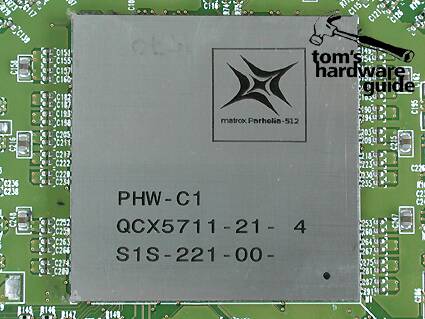Attack Out Of The Blind Spot: Matrox Parhelia-512
Introduction
It's always the same thing when a new graphics card is launched: prior to the launch, you get a test sample, and at the same time you have to sign an NDA (Non-Disclosure Agreement), which is supposed to ensure that you don't leak out the information received before a certain date. And it was the same story with the Matrox Parhelia card, which has been eagerly awaited by many readers. However, Matrox didn't send out the card until quite late - to be exact, Monday June 17 was when they sent out a test sample from Canada, via express mail, to our lab in Munich, Germany. Apparently, they were under the impression that this was plenty of time to review the product before the NDA was lifted today (June 25).
To make things even more exciting, UPS Germany received the card the next day on June 18, but they left it lying around at the airport in Cologne until June 20, and were unable to tell us why. And so, the test sample finally got to our lab on Friday, June 21. The initial tests got off to a good start, when our system choked on a VESA VGA bug in Parhelia, which appeared in connection with the DOS boot manager (XOSL) in our testing systems. More on that later.
Needless to say, all these events made for an extremely tight time limit, hindering extensive testing of the card. Therefore, we will be presenting the Parhelia test in two parts. In Part I, we bring you a detailed look at the 3D performance in comparison to an NVIDIA GeForce 4 Ti4600 card (which, at a street price of about $350, belongs to about the same price class) and the ATI Radeon 8500 128 MB card (which is clearly less expensive, priced at approx. $200).
We will be bringing you a test of the Parhelia's 2D characteristics at a later time, when we've gained more practical experience with day-to-day use of the Parhelia in the multiple-screen mode. The theoretical capabilities have already been discussed in our May article, "Matrox Parhelia - The Challenger." If you haven't read this yet, you should take a quick look at it in order to get an overview of what the Parhelia can do.
Matrox Parhelia - The Card
For starters, Matrox will be offering the market two versions of the Parhelia. One of them will be a fully equipped retail version with a $399 price tag, as well as a bulk version for $349 (estimated). Both cards come with 128 MB, but with different clock speeds for the GPU and the memory. Later this year, 64 MB and 256 MB versions are expected to follow.
- Bulk: 128 MB DDR; GPU clock: 200 MHz; memory clock: 250 MHz (DDR); price: approx. $349
- Retail: 128 MB DDR; GPU clock: 220 MHz; memory clock: 275 MHz (DDR) ; price: approx. $399
The surprise here is the very low 220 MHz clock speed of the GPU, based on the 0.15-µm process, which Matrox claims is the price for the large number of transistors (80 million). After all, NVIDIA is able to clock its 4600 to 300 MHz and the memory to 650 MHz.
| Header Cell - Column 0 | MatroxParhelia-512 | NVIDIAGF4 Ti 4600 | ATIRadeon 8500 |
|---|---|---|---|
| Chip Technology | 512 bit | 256 bit | 256 bit |
| Manufacturing Process | 0.15 Micron | 0.15 Micron | 0.15 Micron |
| Transistor | 80 Mio | 63 Mio | 60 Mio |
| Memory-Bus | 256 bit DDR | 128 bit DDR | 128 bit DDR |
| Memory Bandwidth | 18 GB/s | 10,4 GB/s | 8,8 GB/s |
| AGP Bus | 1x/2x/4x/8x | 1x/2x/4x | 1x/2x/4x |
| Memory | 128 MB | 128 MB | 128 MB |
| GPU-Clock | 220 MHz | 300 MHz | 250 MHz |
| Memory Clock | 250 (500) MHz | 375 (650) MHz | 250 (500) MHz |
| BGA Memory | 3,3ns | 2,8ns | 3,3ns |
| Vertex Shader | 4 | 2 | 1 |
| Pixel Pipelines | 4 | 4 | 4 |
| Texture Steps/Pipe | 4 | 2 | 2 |
| Pixel Shader Steps/Pipe | 5 | 2 | 2 |
| Textur Shader Steps | 36 | 16 | 16 |
| Vertex S. Version | 2 | 1.1 | 1.1 |
| Pixel S. Version | 1.3 | 1.3 | 1.4 |
| DirectX Generation | 8.0 / 9.0 | 8 | 8.1 |
| FSAA Modi | Fragment /SuperSampling | MultiSampling | SuperSampling |
| Z-Date Compression | - | Yes | Yes |
| Monitor Outputs | 3 | 2 | 2 |
| Chip Internel Ramdacs | 2 | 2 | 2 |
| Chip Externel Ramdacs | 1 | - | - |
| Max. Dual Resolution | 2048x1536 @ 32bpp | 1600x1200 @ 32bpp | 1600x1200 @ 32bpp |
| Max. Triple Resolution | 3840x1024 @ 32bpp | - | - |
| Bits per Color Channels | 10 | 8 | 8 |
Get Tom's Hardware's best news and in-depth reviews, straight to your inbox.
